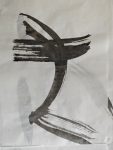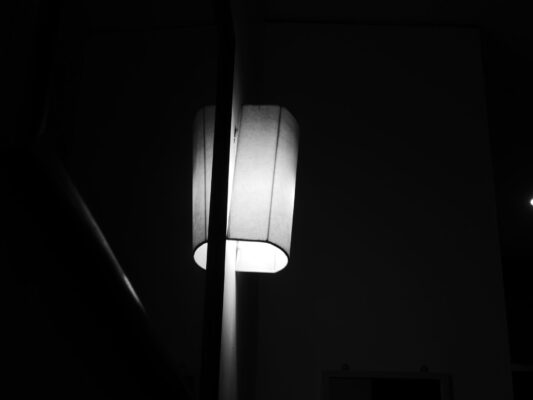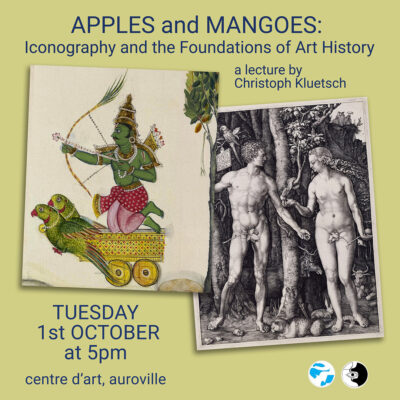GYesterday I met with a gallery owner in Pondicherry. I want to learn more about the artists in the region, the inspirations, the artistic practice, the visual language, the spiritual depth, the narratives, the studios, the biographies, the temples they visit. At the same time, I am discussing a video format with some Aurovillians about the art landscape around Auroville. My training as a Western art historian is not always helpful, there is so much I have to forget first - 'unlearning'. I have always told my students the same thing: forget what you have learned in the survey lectures, that is the history of the victors and ideologues. Art is something else. Well, now I'm learning a little about myself, I'm being reminded and encouraged, I'm reaching my limits.
The conversation yesterday didn't open my eyes, but my senses. Again and again, it is the Upanishads that are the key. I often feel like a novice. Every serious conversation I have here brings to light many new concepts that I don't know. This gives my conversation partner an idea of how deeply I have delved into the Vedic scriptures, the meaning of the temples, the code of the Agama I got in. And of course I have to admit that I'm really only scratching the surface. But it becomes roughened, more permeable, dust and seeds collect in its scratches and traces, it starts to sprout.
My idea of art rejects the concept of representation. Kriti, my conversation partner yesterday, spoke of a retinal attitude in this context. European discussions are always only about what happens on the retina, not about what happens behind it. The vibration of the senses, the fire of cognition, the states of consciousness beyond the material navigation of physical reality.
At the same time, she says that India is often about visual storytelling. How does that fit together?
Body without organs
I think of Deleuze Logic of Sensation, how the eye merges with the canvas, the ear sees better, the forces of distorted bodies become visible on the canvas. And how the artist Francis Bacon's final splash of color at the end of the artistic process exposes the work to intuitive, cosmic, random processes to either complete or destroy the work. Deleuze talks about vibration, about surrender, about the fluid boundaries of the physical body, but also about a body without organs. His thinking is not so far removed from the Kena Upanishads. Elsewhere, Deleuze writes about 'body without organs' (bwo):
"Inscribed on the plane of consistency are haecceities, events, incorporeal transformations that are apprehended in themselves; nomadic essences, vague yet rigorous; continuums of intensities or continuous variations, which go beyond constants and variables; becomings, which have neither culmination nor subject, but draw one another into zones of proximity or undecidability; smooth spaces, composed from within striated space. We will say that a body without organsor bodies without organs (plateaus) comes into play in individuation by and haecceity, in the production of intensities beginning at a degree zero, in the matter of variation, in the medium of becoming or transformation, and in the smoothing of space. A powerful nonorganic life that escapes the strata, cuts across assemblages, and draws an abstract line without contour, a line of nomad art and itinerant metallurgy.
Does the plane of consistency constitute the body without organs, or does the body without organs compose the plane? Are the Body without Organs and the Plane the same thing? In any event, composer and composed have the same power: the line does not have a dimension superior to that of the point, nor the surface to that of the line, nor the volume to that of the surface, but always an anexact, fractional number of dimensions that constantly increase or decrease with the number of its parts. The plane sections multiplicities of variable dimensions. The question is, therefore, the mode of connection between the different parts of the plane: To what extent do the bodies without organs interconnect? How are the continuums of intensity extended? What is the order of the transformational series?" (Deleuze A 1000 Plateaus p. 507)
I think that the very broad Term 'body without organ' helps here. The Upanishads are essentially about the relationship between Brahman and the world. In order to experience itself, Brahman creates a self (atman), a consciousness (purusha), which is realized through nature (prakriti). The physical world is a habitat for the forces that emerge from Brahman - in Hinduism as gods. The configuration of this reality is Brahman, which experiences itself. Brahman is Atman, unity and diversity are not opposites, they contain each other.
There is a parallel in the orientation towards a philosophy of immanence a non-dualistic philosophy. How is the complexity of consciousness to be recognized as immanence? Aurobindo's first answer would be that rationality is not capable of this. It must be transcended, transcended. Only by giving up the small self, the ego, do truly meaningful experiences become possible. The states of Satcitananda allow us to participate in the unfolding of consciousness. It is this unfolding that Deleuze describes materially. What Aurobindo describes through the differentiation of consciousness, Deleuze describes through the movements and connections of thought and the senses.
Storytelling
So I ask myself, what kind of stories are these? What stories are being told? My impression is that many works by contemporary artists in India are not about telling autobiographical stories, even though their own experience and biography often clearly resonate. But that is not the issue. It is not about asking what the artist:in us wanted to say with it. That's why the Tasmai Gallery no explanatory text, not even names, titles etc... The works are simply on the wall, standing for themselves.
The images do not represent a story. It is true that in India, as in every cultural tradition, there are narratives of mythological, religious or imperial character that form the fabric of a 'cultural fabric'. In India, the many figures from the epics and temples are omnipresent. But it is difficult for everyone to always decipher them. There are so many local traditions, the subcontinent is huge, that it is not so much a question of Indians or non-Indians being able to decode the visual language. It is the artists' personal exploration of their own experience. These narratives are designed to allow points of connection - a rhizome, a plateau, a level.
When I see a work that may seem a little naive at first glance, I find myself thinking and categorizing retinally in my Western mind. Missed the mark ... Second attempt. What experience is being felt here? How does my eye move? How does my body move, where do I linger, where does a connection arise between my experience and what I see? What mental images arise in my mind, what spiritual experience is evoked? These are the questions that point me in the right direction.
What is happening here on an empirical level? The art historian in me wonders, how can I talk about this? Experiences of Satchitananda are difficult to communicate. I then fall back on Deleuze. The ear sees better. The logic of sensory experience is a logic that is not a logic. It is not a propositional logic, it is not about true or false. Nevertheless, it is not random, arbitrary. The senses are held together by vibration, and this is where the Kena Upanishad continues. Who thinks when thinking, who sees when seeing?
"By whom missioned falls the mind shot to its mark? By whom yoked moves the first life-breath forward on its paths? By whom impelled is this word that men speak? What god set eye and ear to their workings?" (Kena Upanishad, Aurobindo's translation)
It is the body without organs (bwo), Brahman experiencing itself, a consciousness that transcends the ego. There is a resonance in the vibration. It is the rhythm that structures and connects. When birds chirp, the rhythm enables communication, they form a community, a habitat. This is how milieus and territories are formed, within which a self is constituted. An inside and outside emerge, a House is built. This is how art is created. Theory always lags behind. Mother India tells many stories.
"That is full; this is full. The full comes out of the full. Taking the full from the full the full itself remains.
Aum, peace, peace, peace." (Invocation of Isha Upanishad)








